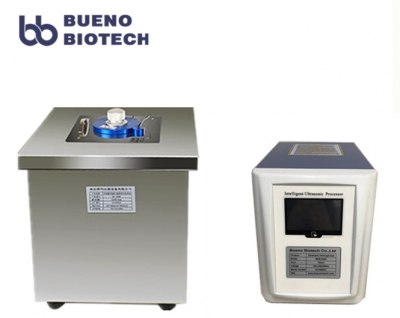Product Description
The traditional ultrasonic probe sonicator has direct contact with the sample, which is contaminated by metal ions. It can only handle one sample at a time, and the experimental period is long. For multiple samples, the same probe needs to be used repeatedly, which may easily cause cross contamination of samples. Due to the different depth of the probe inserted into the sample, the energy distribution of each ultrasound is also different, which affects the repeatability and accuracy of the experimental results. In addition, because closed systems are not available, aerosol or foam generated during the ultrasonic process can diffuse into the environment, posing a potential biological hazard.
Non-contact Ultrasonic Crushing Processor is used for aseptic crushing, which can break chromosomes and break cells through centrifugal tube. There is no need to operate the probe frequently. Each sample is in a separate fully enclosed test tube to avoid cross contamination. It is specially tailored for the pre-treatment of second-generation sequencing DNA samples and chromatin immunoprecipitation experiment samples.
Compared with the traditional probe ultrasonic cell processors, the non-contact ultrasonic processors can be broken under the sealed container without infectious flying fog, and the ultrasonic probe does not contact the samples to avoid cross contamination. More than one sample can be processed at the same time, and the experiment efficiency is high. No wear, slag drop phenomenon, each sample is in a separate completely closed test tube, avoid cross contamination; Low temperature and thermostatic bath can be selected to maintain the temperature of samples at -5 to 100 degrees Celsius. The experimental procedures are standardized, the experimental repeatability is good, and the results are reliable.
Product Features
-
Aerosol free aerosols - enhanced biosafety for aseptic operations; (e.g. Mycobacterium, hepatitis b virus, hepatitis a virus, influenza (including H1N1), SARS virus SAS)
-
Eliminating the risk of sample cross contamination; Can break through the centrifuge tube can break chromosomes, broken cells
-
Eliminating the traditional hand-held probe, fixed probe tedious, with sound suppression device
-
Liquid crystal display(Touch Screen), power can be fine - tuned
-
Using periodic pulse to break cells, the start and end time of the pulse can be adjusted, and the adjustable time is accurate to 0.1 second
-
Multiple samples can be processed at one time, with a wide range of sample processing
-
LCD large screen display, the program can be set to store 20 groups of experimental data, with overtemperature, delay, fault protection, and independent overtemperature, delay,
-
The fault alarm system greatly protects the test samples and is easy to operate.
Technical Specification
|
Model |
BESM-1500W |
BESM-2200W |
|
Frequency |
20 |
20 |
|
(KHz) |
||
|
Power(W) |
1500 |
2200 |
|
Centrifugal tube clamp |
(0.1-2ml)*4holes |
(0.2-0.5ml)*45holes |
|
(standard) |
||
|
Centrifugal tube clamp (optional) |
0.2ml*8holes 5ml*3holes |
1-2ml*32holes、5ml*20holes 10-15ml*17holes、50ml*6holes |
|
Input & Display |
Touch screen(4.3TFT) |
Touch screen(4.3TFT) |
|
Sample temperature adjustable (℃) |
-5~100 (cooling thermo bath is required) |
-5~100 (cooling thermo bath is required) |
|
Protection device |
Self-diagnosis function, program automatic error correction, overload, overtemperature protection display, etc |
Self-diagnosis function, program automatic error correction, overload, overtemperature protection display, etc |
|
Optional device |
Computer online function, data storage 20 sets, printing, automatic sound insulation |
Computer online function, data storage 20 sets, printing, automatic sound insulation |
Application
The non-contact ultrasonic processors are widely used in biology, microbiology, physics, zoology, agriculture, pharmacy, petroleum and other fields of teaching, scientific research, production. Such as cell fragmentation, lysis; Extraction of protein and nucleic acid; Trim the DNA/RNA; Nanotechnology research; Chromatin immunoprecipitation technique; Sample homogenization and emulsification; Other sample processing.

